Canadian Airlines
This article needs additional citations for verification. (September 2009) |
 | |||||||
| |||||||
| Founded | 1987 (amalgamation) | ||||||
|---|---|---|---|---|---|---|---|
| Ceased operations | 2001 (acquired by Air Canada) | ||||||
| Hubs | |||||||
| Focus cities | |||||||
| Frequent-flyer program | defunct (formerly Canadian Plus) | ||||||
| Alliance | Oneworld (1999-2000) | ||||||
| Subsidiaries | Canadian Regional Airlines | ||||||
| Fleet size | 97 | ||||||
| Destinations | 160 in 17 countries | ||||||
| Parent company | Canadian Airlines Corporation | ||||||
| Headquarters | Calgary, Alberta | ||||||
| Key people | Kevin Benson (President and CEO) | ||||||
Canadian Airlines International Ltd. was a Canadian airline that operated from 1987 until 2001. The airline was Canada's second largest airline after Air Canada, and carried more than 11.9 million passengers to over 160 destinations in 17 countries on five continents at its height in 1996. Canadian Airlines served 105 destinations in Canada, more than any other airline. Canadian Airlines was also a founding member of the Oneworld airline alliance.
Canadian Airlines was headquartered in Calgary, Alberta,[1][2] and had revenue of approximately $3 billion at the end of 1999. The airline and its aircraft were acquired by Air Canada in 2000, and the merger was officially completed on January 1, 2001.[3]
History
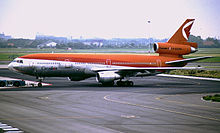
Canadian Airlines International was the principal subsidiary of its parent company Canadian Airlines Corporation. The new airline was formed on March 27, 1987, when Pacific Western Airlines purchased Canadian Pacific Air Lines (which operated as CP Air for a number of years), which in turn had recently acquired Eastern Provincial Airways and Nordair.
In 1989, Canadian Airlines acquired Wardair, giving them access to new routes including long sought-after routes to the UK and Europe. Its major hubs were at Montréal-Dorval International Airport (now known as Montréal-Pierre Elliott Trudeau International Airport), Toronto Pearson International Airport, Vancouver International Airport, and Calgary International Airport.
Canadian Airlines streamlined its operations and went through the financial restructuring of over $700 million in debt, after the 1991 airline industry slump. It was further aided by an injection of cash from the American Airlines Group.
On November 1, 1996, Kevin Benson, then president and CEO, unveiled a restructuring strategy to improve the profitability of Canadian Airlines. The operational restructuring plan was supposed to be phased in over a four-year period, addressing the main issues of cost control, revenue growth, capitalization and fleet renewal. It was also one of the founding members of the Oneworld airline alliance, along with Qantas, American Airlines and British Airways. The plan started off well but with the Asian economic downturn in 1998, air traffic decreased and Canadian was suffering on what was previously its most profitable route.

Canadian Plus was the largest frequent flyer program in Canada with more than 60 airline, hotel, car rental, and financial partners worldwide. The program had more than three million members.
In its last few years of operation, Canadian Airlines extended its international route network in Asia, with the most recent expansion of service to Malaysia and the Philippines, which gave it eight destinations in Asia. At that time Canadian Airlines had the distinction of flying to more places in Asia, more often, than any other Canadian carrier.
Canadian Airlines' core business strategy focused on building its Vancouver hub into the leading gateway between North America and Asia. It leveraged its codesharing agreement with American Airlines in order to help capture a greater share of U.S.-Asia traffic flows.
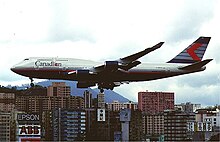
After continued poor performance, Canadian Airlines was acquired by Air Canada in 2000. Numerous other proposals for survival had been considered and rejected, including a competing bid led by American Airlines to purchase Canadian Airlines. American Airlines had already owned a 25% stake in Canadian Airlines, the maximum allowed under regulations. Then-American CEO Donald J. Carty, who had formerly headed Canadian predecessor Canadian Pacific Air Lines, planned to acquire a controlling interest in the new Air Canada, with the purpose of moving it from the Star Alliance to Oneworld. American has since sold its shares in Air Canada, after unsuccessfully lobbying Canadian federal government to ease foreign ownership restrictions on Canadian airlines.
At the time of merger, Canadian Airlines carried over 40% of the domestic share of passengers in Canada. Following the completion of the acquisition, Air Canada controlled over 90% of the domestic share of passengers, and dominated international and US-Canada transborder traffic.[4]
Internet presence
Canadian Airlines has the distinction of being the first airline in the world to have a website on the Internet (www.cdnair.ca). The website was launched in April 1994 and is recognized in the Canadian Internet handbook[5] 1994 and 1995 editions. It was given recognition for not only being the first airline website in the world but also the first with transactional capabilities such as flight arrival/departure and fare information. At the time, this fact was widely reported by Canadian media including CBC Venture and Maclean's Magazine. The website was created and credited to Grant Fengstad who at the time was leading a strategy to demonstrate that the Internet was going to revolutionize the travel sector.[citation needed]
Destinations
Livery
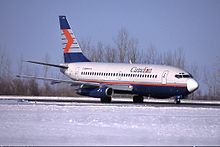
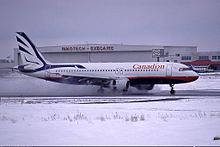
Upon its founding in 1987, Canadian Airlines revealed its new livery using the colours light grey, dark grey, navy blue, and red. The lower half of the aircraft's body was navy blue, topped with light grey and red borders while the tail was two-thirds blue, with the remaining third taken up by the carrier's logo. This was a light grey colour. Over the light grey were five dark grey lines, representing the five continents served by the carrier. Over these lines was a thick, bright red chevron. This character was a clever alternative to a true bilingual name on the fuselage (Canadian/Canadien).
Canadian adopted a short-lived new livery in January 1999, less than a year before the airline was merged into Air Canada. The livery, known as "Proud Wings", featured a large Canada goose painted at the tail of the aircraft and the airline's name in a new Celeste font.[6] The new livery, however, came so late that most of the fleet still retained the existing chevron livery by the time of the merger. Until the merger process with Air Canada was completed in 2001, most Canadian aircraft featured a transition livery with an Air Canada tail design while retaining the name "Canadian" on the sides.
Fleet
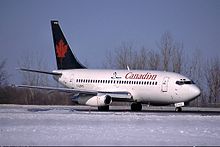
When Canadian Airlines was acquired by Air Canada in 2001, its fleet contained these aircraft:
| Aircraft | Total | Orders | Notes |
|---|---|---|---|
| Airbus A320-200 | 13 | — | 9 aircraft remain in service with Air Canada. |
| Boeing 737-200 Adv. | 43 | — | |
| Boeing 747-400 | 4 | — | |
| Boeing 767-300ER | 23 | — | Some aircraft remain in service with Air Canada and Air Canada Rouge. |
| McDonnell Douglas DC-10-30 | 14 | — | Fleet was not transferred to Air Canada. Sold or retired by completion of merger. |
| Total | 97 |
Jet fleet
- Airbus A310-300 (from Wardair, five aircraft sold to Canadian Forces in 1992 and the rest sold to other airlines in 1990s; replaced by Boeing 767-300ER)
- Airbus A320-200
- Boeing 737-200, 200-ELR and 200-Combi
- Boeing 737-300 (leased only by CP Air at the time of merger, returned to lessor in the late 1980s)
- Boeing 767-300ER
- Boeing 747-400
- McDonnell Douglas DC-10-10 (Operated by CP Air. Leased from United Airlines, returned in 1987)
- McDonnell Douglas DC-10-30
- Fokker F28 Fellowship-1000 (operated by Canadian Regional Airlines)
- Fokker 100[citation needed]
Turboprop fleet
Besides operating F28 jet aircraft, Canadian Regional Airlines also operated the following turboprop aircraft types on behalf of Canadian Airlines via a code sharing arrangement:
- British Aerospace BAe Jetstream 31
- de Havilland Canada DHC-8 Dash 8-100 and -300
- Beechcraft 1900D
- ATR-42
- ATR-72
In-flight services
Canadian Airlines offered three classes:
- First Class (F)
- Business Class (J)
- Canadian Class (Y)
- referred to as Economy Class on turboprop aircraft
First Class was available on flights using wide body jets and Business Classes on flights not using regional jets or turboprop aircraft.
In 1987 Canadian Airlines banned smoking on all domestic flights.[7]
Food
Food from flights within Canada were provided by LSG Sky Chefs and all other flights by local contractors.
Maintenance
Maintenance was provided by in-house operations during the existence of the airlines. Aircraft would be serviced by other airlines at airports without CA operations.
Ground handling
Ground handling was provided by in-house operations during the existence of the airlines. Aircraft baggage would be handled by Hudson General and the interior cleaning and lav and potable service, carpet replacement, seat back and seat covered replacement was handled by Canadian Airlines Cleaning department at airports within CA operations.
Entertainment
Most international and medium haul flights provided both video and audio entertainment. Short haul flights provided audio entertainment only.
Newspapers and magazines
Newspapers provided in-flight on most aircraft:
- Canadian – the official in-flight magazine of Canadian Airlines
- newspapers – Globe and Mail, USA Today
- magazines – Maclean's
Lounges
Canadian lounges were called Empress Lounge and were located at several airports in Canada and abroad:
- Calgary International Airport
- Edmonton City Centre (Blatchford Field) Airport and Edmonton International Airport
- Halifax International Airport
- Montréal-Dorval International Airport and Montréal-Mirabel International Airport
- Ottawa International Airport
- San Francisco International Airport, California, United States
- Toronto Pearson International Airport Terminal 3
- Vancouver International Airport
- Ezeiza International Airport, Buenos Aires, Argentina
- Mexico City International Airport, Mexico
- Galeão - Antônio Carlos Jobim International Airport, Rio de Janeiro, Brazil
- Guarulhos International Airport, Sao Paulo, Brazil
- Don Mueang International Airport, Bangkok, Thailand
- Beijing Capital International Airport, China
- Kai Tak Airport, Hong Kong (before 1998)
- Hong Kong International Airport (Chek Lap Kok), Hong Kong
- Komaki Airport, Nagoya, Japan
- Taiwan Taoyuan International Airport, Taipei, Taiwan
- Narita International Airport, Tokyo, Japan
- Auckland Airport, New Zealand
- Kingsford Smith International Airport, Sydney, Australia
- Frankfurt International Airport
- London Heathrow Airport, England, United Kingdom
- Malpensa International Airport, Milan, Italy
- Charles de Gaulle Airport, Paris, France
- Leonardo da Vinci International Airport, Rome, Italy
Subsidiaries
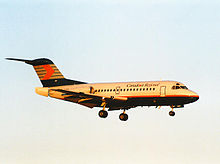
Canadian Airlines' domestic network was broken down into five divisions:
- Canadian Regional Airlines, which served 69 destinations in British Columbia, Alberta, Saskatchewan, Manitoba, the Northwest Territories, Ontario, and the United States. Canadian Regional was 100 percent owned by Canadian Airlines.
- Calm Air which served 27 destinations in Manitoba, northwestern Ontario, and the Northwest Territories. Calm Air was 45 percent owned by Canadian Regional and continues to operate under separate management.
- Inter-Canadien served Ottawa, Toronto, Labrador, and 26 destinations throughout Quebec. Inter-Canadien was 100 percent owned by Canadian Regional.
- Air Atlantic, a regional partner of Canadian Airlines, served 16 destinations throughout the Atlantic provinces, Quebec, Ontario, and the United States.
- Canadian North was a division of Canadian Airlines created to serve the northern regions. Canadian North had a network of 10 destinations that expanded from its southern bases of Edmonton and Winnipeg. Canadian North also had a commercial agreement with Aklak Air, an Inuit-owned and operated airline in the Northwest Territories. Canadian North was sold in 1998 to Norterra and continues to operate as an independent airline.
In addition to flight providers, Canadian Airlines operated the largest tour operator in Canada called Canadian Holidays and the Canadian Getaways program. The operator flew to destinations which included destinations throughout North and South America. Their freight operation, Canadian Air Cargo, provided general air cargo services in Canada and the United States.
Onex bid and Air Canada takeover
On August 20, 1999, Air Canada proposed a financial offer to Canadian Airlines which would see Canadian's International routes and airport slots sold to Air Canada for an undisclosed amount. Canadian Airlines would be relegated to be a regional carrier providing a feeder network to Air Canada. This offer was rejected.
Four days later, on August 24, 1999, Onex Corporation announced a takeover bid for Canadian Airlines, backed by American Airlines parent company AMR Corporation, consisting of $1.8B in cash and the assumption of $3.9B in debt. Canadian Airlines announced that it would support this and recommend acceptance from its shareholders. Air Canada rejected the offer. On August 31, 1999, Air Canada adopted a poison pill aimed at thwarting any takeover bid.
It was later (Sep 24, 1999) revealed by Kevin Benson that merger talks had occurred between Canadian Airlines and Air Canada in early 1999 with Air Canada abandoning the talks.
On October 19, 1999, Air Canada, backed by Star Alliance partners Lufthansa Airlines, United Airlines and CIBC announced a $930M counter bid to the Onex offer. Air Canada offered $92M for Canadian Airlines and committed to running it as a separate company. On November 2, Air Canada increased its offer to $16 per share to buy back 36.4 percent of the airline.
On November 5, 1999, a Quebec judge ruled that the Onex takeover was illegal, breaking the law that stipulates that no more than 10 percent of the company can be controlled by a single shareholder. Onex subsequently withdrew its offer and Air Canada stated it would proceed with the takeover of Canadian Airlines. On December 4, the board of directors at Canadian Airlines recommended the $92M offer from Air Canada to the shareholders. The offer from Air Canada originally expired at 5pm on December 7, 1999, but Air Canada extended their offer until December 23, 1999. Air Canada officially took control of Canadian Airlines, pending government approval, on December 8, 1999. The Federal Competition Bureau cleared the way for the takeover on December 21, 1999 and Canadian Airlines officially became a subsidiary of Air Canada on December 23, 1999.
Canadian Airlines operated as a subsidiary company through most of 2000. In October 2000, all of Canadian Airlines' systems and employees became fully integrated. WIth both companies fully integrated, Air Canada began massive cuts to employees starting with the announcement that there would be 3500 cuts in the workforce on December 22, 2000. September 26, 2001 saw an additional 5000 cuts primarily driven from the worldwide impact to the travel sector caused by the 9/11 attacks.
Media appearances
In 1994, the Canadian Children's show Mighty Machines filmed one of their episodes (Mighty Machines at the Airport) at Toronto Pearson International Airport, starring a couple of Canadian Airlines jets (a McDonnell Douglas DC-10, a Boeing 737-200 and an Airbus A320) and several other of the carrier's vehicles.[citation needed]
In the 1996 film, Homeward Bound 2: Lost in San Francisco the family is flying to Canada on Canadian Airlines when the pets escape. The pets then chase after the Canadian Airlines jet and sit on the runway as the Canadian 737 takes off over their heads. During this scene many other Canadian Airlines planes are visible.[8] The scene, while supposed to be at San Francisco International Airport, was actually filmed at the Abbotsford International Airport in Abbotsford, British Columbia.[9]
Accidents
No fatalities occurred on Canadian Airlines flights.[10] There were only two major incidents:
- On October 19, 1995, a McDonnell Douglas DC-10ER rejected takeoff due to compressor stall and subsequently over-ran the end of the runway at Vancouver International Airport.[11]
- On September 6, 1997, a Boeing 767-375ER aborted takeoff after experiencing an engine fire at Beijing International Airport.[12]
References
- ^ "Investor & Financial Information." Canadian Airlines. March 3, 2000. Retrieved on May 20, 2009.
- ^ "World Airline Directory." Flight International. p. 59. "#2800-700 2nd Street SW, Calgary, T2P 2W2, Alberta, Canada"
- ^ "Air Canada Moments".
{{cite web}}: Cite has empty unknown parameter:|dead-url=(help) - ^ "The Air Canada/Canadian Airlines Merger: A Uniquely Canadian Antitrust Experience".
{{cite web}}: Cite has empty unknown parameter:|dead-url=(help) - ^ Broadhead, Jim Carroll, Rick (1994). Canadian Internet handbook (1994 ed.). Scarborough, Ont.: Prentice Hall Canada. ISBN 9780133043952.
{{cite book}}: CS1 maint: multiple names: authors list (link) - ^ "Typographic Branding." Upper & Lower Case Magazine. Issue 28.1.1. Retrieved on June 24, 2009.
- ^ Kramon, Glenn. "Northwest Airlines Bans Smoking on Most Flights." The New York Times. March 24, 1988. 2. Retrieved on February 8, 2012.
- ^ TheDieHardWWEAddict (2015-03-26), Homeward Bound II Lost In SF Scene - Escaping Airport Security, retrieved 2017-02-22
- ^ Fox, Michael J.; Field, Sally; Waite, Ralph; Michaels, Al (1996-03-08), Homeward Bound II: Lost in San Francisco, retrieved 2017-02-22
- ^ "Canadian Airlines International". Aviation Safety Network. Retrieved August 8, 2012.
- ^ "Aviation Investigation Report A95H0015". Canada.gc.ca. Transportation Safety Board of Canada (TSB). Retrieved August 8, 2012.
- ^ "Aviation Investigation Report A97F0059". Canada.gc.ca. Transportation Safety Board of Canada (TSB). Retrieved August 8, 2012.
Further reading
- Fattedad, S. (2015). An Insider’s Story of the Rise and Fall of Canadian Airlines. Vancouver, BC: Warfleet Press. ISBN 0986879312.
External links
- Official site archived at the Wayback Machine

